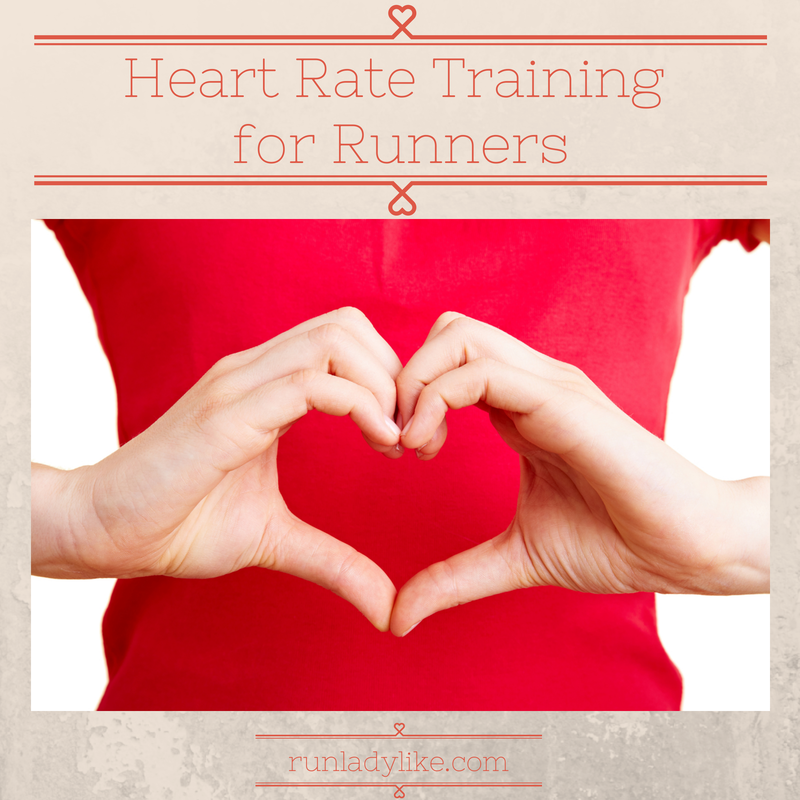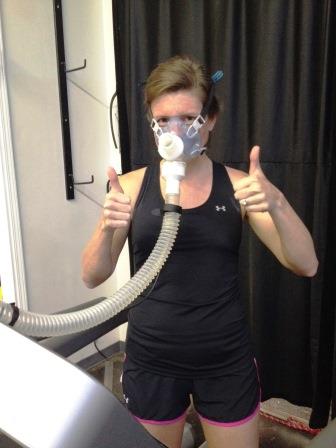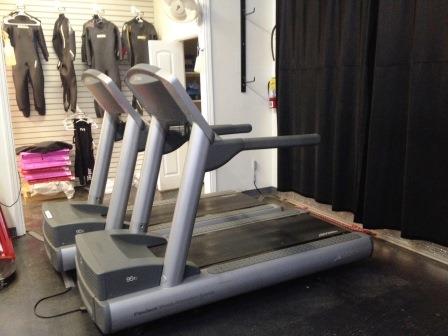Heart Rate Training & Vo2 Max Testing
There are many ways to measure if a run is successful. You might look at distance – how many miles you covered. You may assess your pace – how fast (or slow) you ran. You may consider frequency – simply being consistent with your running or training. Or maybe, you say screw all those things and confirm your run a success if you simply felt good. All of these are important ways to analyze your running and training. But there is another tool you can have in your toolbox to measure intensity – how much effort you invest in your workouts: Heart rate training.

Training with a heart rate monitor can help you better understand how hard you’re running, if you’ve recovered adequately between speed work intervals, how fast you’re using up your energy and the overall effort you’re putting forth. The American College of Sports Medicine recommends that we monitor our heart rate during exercise to make sure we’re exerting the right amount of effort based on our abilities.
Knowing your VO2 max (maximum oxygen consumption) and establishing your heart rate training zones is one way to help ensure we’re adding enough intensity to overload our body without causing over-training or injuries.
Is your head already spinning? I had my VO2 max and heart rate training zones professionally tested last month, and I wanted to share my experience – both as an athlete and a coach. This is a very complex topic, so I will break it down for many of you who may be new to heart rate training. The information I’m sharing comes from the North American Academy of Sport Fitness Professionals and Precision Heart Rate Training by Edmund R. Burke, Ph.D. (a text I highly recommend if you’re thinking about heart rate training).
The Basics
There are a lot of technical terms that can feel a little overwhelming when you begin talking about heart rate training. Let’s review the basics.
VO2 max: VO2 max is the maximum amount of oxygen a person can use while exercising. The more oxygen you can consume while exercising (i.e. the higher your VO2 max), the better your aerobic capacity. My VO2 max for running is 54.9, which falls in the superior category for women age 30-39 (yes, I did a little happy dance when I saw the word “superior”). The best way to determine your VO2 max is with professional testing. Although you don’t necessarily need to know your VO2 max to calculate your heart rate training zones, you will notice how drastically different my zones are based on manual calculation by my maximal heart rate and my professionally diagnosed VO2 max (toward the end of this post).

Resting heart rate: Your resting heart rate is the number of times your heart beats per minute when you’re at rest. The best time to measure it is when you wake up in the morning before getting out of bed. To calculate your resting heart rate, either put on a heart rate monitor or count manually by placing your index finger and middle finger just below the fleshy pocket of skin under your thumb on your wrist. You can either use your heart rate monitor while lying down or count the number of pulses during a 60-second period to determine your resting heart rate. Do the same thing for 5 to 7 days and then take the average. Really fit athletes can have resting heart rates that are less than 50 beats per minute. Mine is around 52 beats per minute.
Maximal heart rate (MHR): Your MHR is the highest number of times your heart can contract (beat) in one minute. Reaching your MHR would occur when you’re running or exercising at an all-out pace. This number is needed to calculate your heart rate training zones. There are 2 ways to determine your MHR.
- The best way is to get professionally tested at a sports facility or clinic. This typically costs between $100 and $200. The professional will help you put on a heart rate monitor and will also place a mask over your face that is attached to a machine. You will run on a treadmill for typically 7 to 12 minutes until you reach a plateau. Every minute, the technician will increase pace and incline, alternating between the two until failure. I went for 13 minutes. On the bike, you will do the same thing, except you will alternate between pace and gears until failure. I went 7 minutes on the bike. Your professional test will not only yield MHR, but also VO2 max, anaerobic threshold (described below), heart rate training zones and more.




- If professional testing is not a possibility, you can use the general calculation below:
220 – your age = MHR
Because this equation is just an average, it can vary by 15 beats per minute. Without getting professionally tested, your resulting heart rate zones could be off quite a bit.
Let’s look at my numbers as an example.
My MHR during a professional treadmill test last month for running is 184. If I use the equation above (220 – 32 years old), my MHR is 188. In this case, it is only 4 beats per minute off. One other thing to note is that your MHR is sport specific, meaning your MHR for running may be different for biking. My MHR for the bike is 176. It’s common for your bike MHR to be lower than that for your running.
Your MHR decreases as you age, and females typically have a lower MHR than males.
Anaerobic threshold (AT): Your AT is the point at which you have reached a certain intensity level in your workout when your body can no longer supply enough oxygen to keep up with the demand you’re putting on it. We begin to build up lactic acid. We can typically maintain our heart rate associated with this level of intensity for about an hour. Often during training, we work at our AT for about 3 to 5 minutes during speed workouts and interval training, which can help improve our overall fitness and speed. Anerobic threshold is also referred to as our lactate threshold. My AT for running is 178 and is 169 for biking.
Heart rate training zones: Heart rate training zones are ranges of effort based on your maximal heart rate (MHR). There are typically 4 heart rate training zones (sometimes a fifth that gets into very fast speed work) that correspond with different levels of intensity. To improve or maintain your fitness, the rule of thumb is that you want to train between 50 to 85 percent of your VO2 max or 65 to 90 percent of your MHR.
- Zone 1 (Very light activity/aerobic): 50 to 60 percent of MHR – This is typically associated with daily activities, walking and very easy running, such as recovery runs. It is a good zone for beginning runners and athletes just starting out. In zone 1, our bodies are burning fat.
- Zone 2 (Aerobic): 60 to 70 percent of MHR – Zone 2 exercise helps strengthen your heart. Running in this zone will help you get stronger and increase your endurance, cardiovascular capacity and your heart’s ability to pump blood. This is the range in which most of your easy runs will be done.
- Zone 3 (Fitness/performance training): 70 to 85 percent of MHR – This is the most popular intensity zone for increasing fitness. Running in zone 3 is often categorized by the fastest pace you can maintain while still being able to talk and remain somewhat comfortable. Lactic acid typically doesn’t build up during this zone. Running in zone 3 will help you improve your endurance and, over time, increase the pace you can run at without building up soreness and lactic acid.
- Zone 4 (Improved performance/anerobic – “without oxygen”): 85 to 100 percent of MHR – When you are training in zone 4, you will eventually be running at or near your V02 max or MHR, and you will definitely hit your anaerobic threshold (AT). Your body will no longer be able to take in oxygen while exercising, and training at such a pace will begin to teach your body to train/run harder while metabolizing lactic acid better. Zone 4 is the zone in which you will do all your speed workouts and most of your tempo runs.
To determine your heart rate training zones, simply take your MHR that you calculated above (220 – your age) and multiply by the percentages for each zone to find your ranges. Let’s use my data as an example:
Jesica’s MHR: 184
Zone 1: 50-60 percent of MHR:
184 x 0.50 = 92
184 x 0.60 = 110.4
Jesica’s Zone 1: 92-110
Actual from professional testing: 117-151
Zone 2: 60-70 percent of MHR:
184 x 0.60 = 110.4
184 x 0.70 = 128.8
Jesica’s Zone 2: 110-129
Actual from professional testing: 152-161
Zone 3: 70-85 percent of MHR:
184 x 0.70 = 128.8
184 x 0.85 = 156.4
Jesica’s Zone 3: 129-156
Actual from professional testing: 163-170
Zone 4: 85-100 percent of MHR:
184 x 0.85 = 156.4
184 x 1.0 = 184
Jesica’s Zone 1: 156-184
Actual from professional testing (they have zones 4 and 5): 171-197
Additionally, my professional testing yielded the following guidance for heart rate training based on certain types of runs for my current ability level (yours will be different based on your VO2 max and MHR):
- Recovery run: 142 or below (Zone 1)
- Easy run: 142-155 (Zone 1-2)
- Long run: 151-162 (Zone 2)
- Steady state run (slightly slower than race pace): 157-169 (Zone 2/3)
- Tempo run: 171-182 (Zone 4)
- Speed intervals: 176-190 (Zone 4)
- Hill sprints: 176-196 (Zone 4)
Factors that Can Affect Heart Rate Training
There are several factors that can increase your heart rate during exercise. Here are a few to be mindful of if you begin heart rate training:
- Anxiety or stress
- Heat may increase your heart rate as much as 10 beats per minute during an hour of running (or cycling) from exercising at the same effort in more moderate temperatures.
- Cold temperatures may cause an increase in heart rate if you’re dressed in few layers.
- Dehydration and increased body temperature
- Altitude
Later this month, I’ll be talking about heart rate monitors and some other gadgets and gear that can aid in running with a heart rate monitor and getting used to heart rate training.
Do you use a heart rate monitor during running or exercise? If so, tell us what you think and share your advice. What other tips would you add or offer when it comes to heart rate training for runners or triathletes?



Comments
I love this, and I love the way you broke it down. Even with my personal training background, heart rate and training is a tricky beast. I’d be interested in what staying in each zone feels like and whether you or anyone has trouble staying in zone 2 and always wants to be in zone 3.
I have a heart rate monitor that I’ll wear (sometimes) for cross training just to see if I am really pushing myself.
Hi Kim! Glad this was helpful. What I have found recently is that it takes more for me to get into zone 3 than I would think. For instance, last week I was pushing a pace on the treadmill that I thought would skyrocket me into zone 3, but it didn’t … meaning I am starting to be able to run faster without exerting as much effort. However, with the summer heat right now, when I’m outside I can creep into zone 3 faster than normal due to the extra energy it takes to battle the temps. Of course, heart rate training isn’t perfect, but rather a nice additional tool to have to measure our intensity and effort. Most times I like to train based on paces and perceived exertion.
I don’t use a heart rate monitor, but do know a few girls who just started heart rate training.
I use a heart rate monitor with everything but my running. I had to stop using it during my runs because the chest sensor started bothering me. Great post! You really broke it down in an easy way to digest the info.
I am happy to see your testing showed much higher bpm for your zones then the calculations. I started using a heart rate monitor for training a couple months back and feel like the zones are completely off (Set the zones based off calculations like the age one). I will be warming up and my watch will be screaming that my heart rate is too high and it feels like I am barely moving. I now find myself not looking at the heart rate zones because I feel it is so off… maybe I need to get tested!
What a wonderfully informative post!!
I just started HR training 2 weeks ago. And I had a “run test” earlier this week since the zones I had seemed off. I had mine done at Sports Factory last year and it said 212 as max HR and Z1 as under 164. This time Z1 is under 135!!!
Great and informative article! I have been training by heart rate for the past two years and it has literally changed the way I exercise and exert myself. To put it in a nutshell, I basically sweat more. I trained for my last half ironman all by heart rate, and it helped keep me in the proper training zone for the bike so I did not bonk on the run, and it helped me know when to push it more on the run. I have never been professionally tested (I did a running test on hills on my own to determine my MHR),but I would like to get that done this fall. I recommend HR training for everyone – it will literally change your life, just ask any personal trainer who uses it. My only suggestion is that you follow the care instructions on your monitor. I have a Garmin 310 that I use for triathlons, and it will get out of wack and give me inaccurate results if I don’t machine wash the strap every 5 uses. Static guard also helps on workout shirts to prevent inaccurate readings. Also, the softer straps are much more comfortable to wear than the hard, rubbery ones. I love training by heart rate and would strongly recommend that everyone do it instead of RPE, it is much more accurate and will improve your training in any sport, including weight training!
i used to wear a heart rate monitor and then stopped. I actually had a gift certificate to the sports factory from years ago (long story) and I threw it away. I’ve been meaning to do this for a while now just to see where I stand. Thanks for sharing!
I use a heart rate monitor with my Garmin while I run. It does a pretty good job of letting me know where I am at. My bodies happy place seems to be 140-150 bpm range. I can tell my body is starting to work anywhere about 150 bpm and I know I am getting into the danger zone when I am pushing over 165 bpm.
I’ve always been against close monitoring of my heart rate–I just take a more chill approach. But recently I worked out with a pro cyclist and she explained the magic of the zones.
She told me how you can train your mitochondria to become work on less air–which would make you an incredible athlete. She certainly was a byproduct of that!
Very interesting.
This is really interesting to see! Where did you have this done? I tried out running based on my hear rate for awhile but felt like I was running slower than I should have been. I was just using the basic calculations so I’m going to assume that like you my zone would actually be higher in a professional test. That is something I’d love to have done!
Hi Brianna! I had mine done at a place called the Sports Factory in Atlanta. You should be able to google places where you live. For a run test only mine was $125 (it is more if you have the bike done too). Let me know if you get your VO2 max and heart rate zones professionally tested!
This was super interesting and accessible. I’ve read about low heart rate training before, but I really had no idea what kind of investment or pre-work it would require on my part. I’m definitely adding getting professional tested to my running bucket list! Such an awesome running-nerd experience, I bet. Can’t wait to read more about this!
I’m late to this party, but today I had some testing done using software based on some recent racing, and what was found was shocking and similar to what Jesica had. I was running at 122-139 bpm for zone 2, and today was told that my zone 2 is 158-168. Stunned.
Glad you had the chance to be professionally tested. I believe that is critical to effectively use heart rate training as a tool in training. Hope the experience was good.
Jesica, can you share your experience after learning that your zone 2 is 152-161? Did you start running in this zone and start seeing significant results that you may not have seen when doing 110-129? I know you BQ’d sooner than expected. Was that a factor?
Hi Richard! I never trained with a heart rate monitor before getting professionally tested. I have a large/high aerobic range so I didn’t do anything differently after learning this. I only occasionally wear my heart rate monitor, mainly to ensure I’m running slow enough on easy days. I can pretty much tell by feel if I’m too high or low. Getting better/faster is all about consistency, the right plan with speed work, tempos, long runs, etc. and adequate weekly mileage. Heart rate is a great tool to measure intensity and to ensure you’re running your fast runs fast enough and your slow runs slow enough.
Understood. There’s a lot of info out there about getting fast by running slow in zone 2, due to the increase in the heart’s stroke volume which results from adaptations in the aerobic zone. Lowering the resting heart rate, allowing the left ventricle to fill more before pumping, etc. Here’s a great account of it. I have been doing it as well with good success.
http://ironfam.blogspot.com/2013/08/zone-2-training-worksbut-not-today.html?m=1
Awesome. Thanks for sharing!